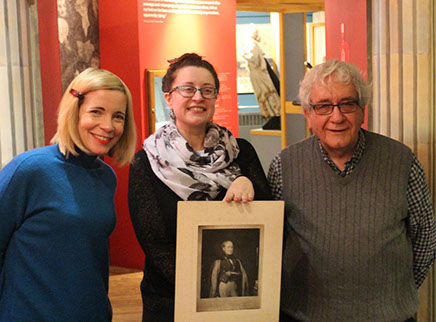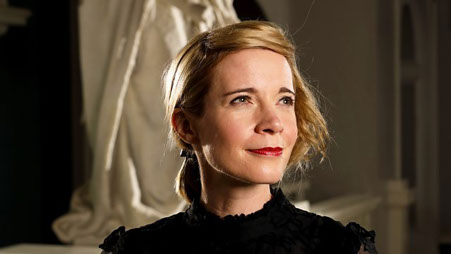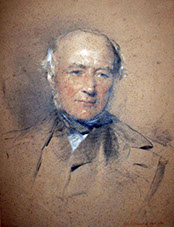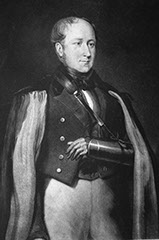
A Wounded Welshman
Mayor Thomas Phillips (1801-26th May 1866)
 Lucy Worsley, Rhian E. Jones and Les James at Newport Museum during recording of the show.
Lucy Worsley, Rhian E. Jones and Les James at Newport Museum during recording of the show.
Lucy Worsley, Chief Curator at Historic Royal Palaces, Rhian E. Jones, Tredegar born writer and ‘Rebecca’ specialist and Editor, Les James got together to talk about the first commoner to dine alone with a monarch at Windsor Castle.
Before they ate dinner together on 9th December 1839, Queen Victoria ceremoniously knighted Sir Thomas Phillips. That’s less than five weeks after he had been wounded at Newport’s Westgate inn.
His life was very much a game of two halves. The stay at Windsor castle, which lasted a week was undoubtedly the game changer.
For generations the forbears of Thomas Phillips led modest lives as small tenant farmers in Breconshire. He too was a Welsh speaker. His father had moved into the Monmouthshire coalfield with the advent of the iron industry in the late eighteenth century.
In the second decade of the nineteenth century, Thomas Phillips senior went into business partnership with Thomas Prothero, attorney at Newport and land agent for the Tredegar estate. And Prothero took on Phillips’s son Thomas as his clerk, and eventually legal partner. Their Newport office was located at the bottom of Stow Hill, opposite the Westgate inn.
By the 1830s, this unholy trinity of father, son and Prothero, together with Thomas Powell, timber merchant, operated a cartel on the river Usk. They controlled the price and sale of coal out of Newport to the ports of the Bristol Channel, including the city of Bristol. Prothero pressurised fellow coal owners in the Sirhowy valley to join his ‘circle’ and drive down the prices paid to contractors and their ‘butties’. Coal operators who resisted, such as Zephaniah Williams, were driven out of business and out of the district. When Williams led the men of the north Monmouthshire to Newport in 1839, he was in dispute with Prothero and Phillips concerning the mine on Penyderi farm, which belonged to his in-laws.
Following the Borough elections in 1831-32 when Sir Benjamin Hall (Whig) unseated the Tory candidate, the Marquis of Worcester, younger son of the Duke of Beaufort, their agents Thomas Phillips (Whig) and Thomas Jones Phillips (Tory) joined forces to defeat John Frost.
Together, they prevented Frost from re-election as mayor in 1837, deterred him from getting back on the Council in 1838, lobbied for his removal from the magistrates bench in April 1839, arrested and imprisoned Henry Vincent and three leading Newport Chartists on 10 May and from April to May they pursued Frost, unsuccessfully convincing the Home Office that he should be arrested. On the evening of November 4 following the battle at the Westgate inn, Frost was arrested by Thomas Jones Phillips.

Listen to Lucy Worsley’s radio 4 programme (no 3 in the series Encounters with Victoria)
GO TO https://www.bbc.co.uk/programmes/m0004sk2
“This is a jam packed 14 minutes”, says Les, applauding producer Mark Burman’s “skillful blending of the thoughts of three talkative historians into a fast moving narrative. We talked in the museum Chartist exhibition, we talked and walked in the footsteps of the Chartists down Stow Hill and at the then boarded up Westgate hotel, I pictured what Phillips did that morning on Monday 4th November at about twenty past nine. Our radio session ends with Rhian explaining what happened to Chartism after the Newport affair - the mass demo at Kennington Common and Victoria’s flight from the ‘danger of revolution’ in London to the safety of Osborne House on the Isle of Wight.”
Les James admits “the story of the Newport mayor, wounded in arm and thigh by ‘slugs’ fired at by an angry crowd is not without controversy. Predictably” he says, “reactions tend to be partisan - and always have been.”
He points out that many Newport artisans and small traders remained loyal supporters of Frost, signing petitions and campaigning for his return home. Although their activities are barely mentioned in the pages of the Monmouthshire Merlin, they turned out in strength at Newport when Frost returned from exile in 1856.
 In contrast, Thomas Phillips, just five weeks or so after his injuries, was feted by the Whig elite at Westminster and Whitehall and given the Freedom of the City of London. He took the opportunity to abandon his legal partnership with Thomas Prothero, attorney and sought his fortune at the bar, to which he was called at the Inner Temple on 10 June 1842. He did not abandon his father’s empire of coal mines and property leases, but continued acquiring land and mineral rights, including Penyderi Farm for his Courtybella coal mine. These investments continued to pay his heirs a handsome, if declining income into the 1940s.
In contrast, Thomas Phillips, just five weeks or so after his injuries, was feted by the Whig elite at Westminster and Whitehall and given the Freedom of the City of London. He took the opportunity to abandon his legal partnership with Thomas Prothero, attorney and sought his fortune at the bar, to which he was called at the Inner Temple on 10 June 1842. He did not abandon his father’s empire of coal mines and property leases, but continued acquiring land and mineral rights, including Penyderi Farm for his Courtybella coal mine. These investments continued to pay his heirs a handsome, if declining income into the 1940s.
His life was very much ‘a game of two halves’. In the years ahead, he sought to become a model entrepreneur, providing schooling for the children of his employees and supporting education throughout Wales. His visit to Windsor, where he stayed a week convalescing was undoubtedly the game changer.
At Windsor, he not only witnessed a very different culture, he also grasped a broader understanding of the machinations of central government. The presence of members of the Privy Council meant he came under pressure from Whig grandees, such as Charles Greville, secretary to the Council and Lord Normanby, Home Secretary who introduced him to the Queen. In three weeks time, a Special Commission was due to open at Monmouth. Some fifty people had been charged with treason. They wanted to know the true state of affairs in south Wales. They feared that heavy handed justice would mean a repeat of rebellion, and no doubt already influenced by the views of such powerful figures as the Marquis of Bute (with Glamorganshire estates), Sir Josiah John Guest, MP for Merthyr and Sir Benjamin Hall, who had been MP for the Monmouth Borough seat (1832-37), now sitting in Parliament for Marylebone, they proffered a political agenda of educational amelioration, as an accompaniment to law and order improvements.
Within days of his visit to Windsor, the thirty-five year old, civil servant Hugh Seymour Tremenheere was instructed (18th December) to visit south Wales by the Committee of Council on Education,
In Newport, 600 landowners, tenant farmers and members of the commercial class in the district, jubilant that the Chartists were defeated, subscribed 800 guineas and commissioned a magnificent service of silver plate for their hero.
“Upon which was an inscription intimating they were presenting it in testimony of their high admiration of the foresight and firmness displayed by him during his mayoralty ..... especially during the night of the 3rd November and the morning of the 4th , whereby he was enabled , under Divine Providence, to frustrate the treasonable designs against the Constitution, and to deliver the town and country from imminent danger.” (W.N.Johns, The Chartist Riots at Newport, 1889 p71)
Ray Stroud asks
What happened to Sir Thomas Phillips’ silver plate?
 Mayor Thomas Phillips 1839This portrait was displayed alongside the service of plate at the Westgate Inn.
Mayor Thomas Phillips 1839This portrait was displayed alongside the service of plate at the Westgate Inn.
The only item that is known to have survived is a silver plate, surmounted with the arms of Sir Thomas, on which is engraved the name of every subscriber.
This was found about 1980 in a scrap metal yard at Colchester. It was acquired by Newport Museum and Art Gallery, where it is on display
SILVER PLATE PRESENTATION TO SIR THOMAS PHILLIPS.
On Wednesday the 23rd the “splendid service of plate was exhibited in the great room at the Westgate... many hundreds of persons viewed it .... “
“comprises a candelabra, two ice vases, one soup tureen, four entre dishes and venison dish, and four dishes in sizes to correspond. “
Subscriptions raised from the inhabitants of Newport and the neighbourhood paid for a service of silver plate costing £862 10s - the workmanship of Benjamin Smith, of No. 12, Duke-street, Lincoln’s inn fields, London.
On Thursday morning the service was removed from the Westgate Inn to the Girls' National School, where it was displayed on a long table resting on a platform in the centre of the hall.
“Two o'clock was the hour named, but long before that time the room was crowded with one of most numerous and fashionable audiences we have ever seen at Newport.” A dinner followed at the Westgate Hotel.
“The Candelabrium or centre ornament is one of great beauty and elegance. It rests upon a triangular base, on one side of it is represented, in bas relief, the attack upon the Westgate Inn on the other are displayed the arms of Sir Thomas Phillips and on the third the following inscription -
THIS CANDELABRUM FORMS THE CENTRAL ORNAMENT, OF A SERVICE OF PLATE, WAS PRESENTED, ON THE 24TH DAY OF SEPTEMBER, TO SIR THOMAS PHILLIPS, KNT., BY UPWARDS OF SIX HUNDRED SUBSCRIBERS FROM THE BRITISH PUBLIC, OP TESTIMONY OF THEIR HIGH ADMIRATION OF THE FORESIGHT AND FIRMNESS DISPLAYED BY HIM DURING HIS MAYORALTY AT NEWPORT, MONMOUTHSHIRE IN 1839, AND ESPECIALLY DURlNG THE NIGHT OF THE 3RD AND THE MORNING OF THE 4TH OF NOVEMBER, WHEREBY HE WAS ENABLED, UNDER DIVINE PROVIDENCE, TO FRUSTRATE A TREASONABLE DESIGN AGAINST THE CONSTITUTlON, AND TO DELIVER THE TOWN AND COUNTRY FROM IMMINENT DANGER.”
On the Pedestal of the Candelabra is a group of five figures: Wisdom and Valour defending Britannia from Rebellion and Anarchy.
The 'vases are highly ornamented with richly-chased vine handles and medallions, one descriptive of the attack on the Westgate, other bearing the following inscription — PRESENTED TO SIR THOMAS PHILLIPS, KNIGHT, BY UPWARDS OF SIX HUNDRED SUBSCRIBERS FROM THE BRlTlSH PUBLIC. 1840
.
The dishes are rich and massive, and have Sir Thomas Phillips crest (a griffin's head, with a dexter - hand coupé in the mouth) wrought in frosted silver as handles and medallions, upon the vases.
There is also a silver plate, surmounted with the arms of Sir Thomas, on which is engraved the name of every subscriber to this splendid testimonial of public esteem and gratitude."
Ray Stroud suggests that it is likely that
t
he silver plate moved to Essex when Thomas Phillips Price (1844-1932), landowner, mine owner and Liberal politician, sold Triley Court, near Abergavenny where he had lived since about 1880.
A captain in the Monmouthshire Militia, a Justice of the Peace, he served as High Sheriff of Monmouthshire in 1882. In 1885 he was elected MP for the newly created North Monmouthshire seat. The auction sale on June 1894 in the Angel Hotel, Abergavenny coincided with his decision to step down at the forthcoming General Election and move to Essex, where he very soon became a county councillor and Justice of the Peace.
Price was the son of the Reverend Canon William Price, vicar of Llanarth and Mary Phillips. sister of Sir Thomas Phillips. At the age of 23, whilst studying at University College, Oxford, he inherited a fortune, sharing with his cousin, William Page Thomas Phillips, barrister at law, the property of his uncle. He embarked on a career of investment in the coal industry.
He was clearly interested in the political battles of his uncle. The South Wales Daily News (9 April 1884) reported that “various ‘curiosities’ connected with the Chartist Riots had been sold at the Westgate Hotel. These included an oil painting of Lieut. Gray, bought by the Free Library for £21, and ‘a pike used by one of the Chartist rioters was purchased for 10 guineas for Mr T. P. Price, Triley Court, a relative of the late Sir Thos. Phillips.” It seems likely that he saw such an item as an addition to existing Chartist memorabilia.
The 1980 ‘find’ in a Colchester scrap yard suggests that he took Sir Thomas Phillips’ silver plate, or at least part of the service, with him to Essex.
In Essex, he first rented Skreens-Roxwell Park, a large mansion near Chelmsford (now demolished) before purchasing in 1898, Marks Hall, a Jacobean brick mansion with a fine deer park located 2 miles (3.2 km) north of Coggeshall.
Thomas Phillips Price lived at Mark’s Hall until his death in 1932.
In 1950, Mark’s Hall was in a derelict condition and was demolished.
Ray Stroud and Les James will be pursuing the trail further next month
AND asking other questions about the life of Sir Thomas Phillips
- what exactly was his role at the Westgate inn that fatal Monday Morning?










